ERP Project Management on ERP: Implementation Challenges and Success
VerifiedAdded on 2023/01/18
|10
|2394
|73
Report
AI Summary
This report provides a comprehensive analysis of an ERP project management case study, focusing on the implementation challenges faced by a medium-sized manufacturing firm. The report details issues such as inadequate project planning, lack of project manager authority, fixed implementation dates, and budget constraints, which led to poor execution and significant consequences, including product returns and employee difficulties. The study explores the specific consequences of these issues, including incorrect system configurations, data import problems, and employee struggles. Furthermore, it offers recommendations for ensuring successful ERP implementation, such as executive management backing, avoiding excessive customization, focusing on easily achievable items, proper employee training, and thorough system testing. The report concludes by emphasizing the importance of proper planning, sufficient resources, and effective project management to mitigate risks and achieve positive outcomes in ERP projects.
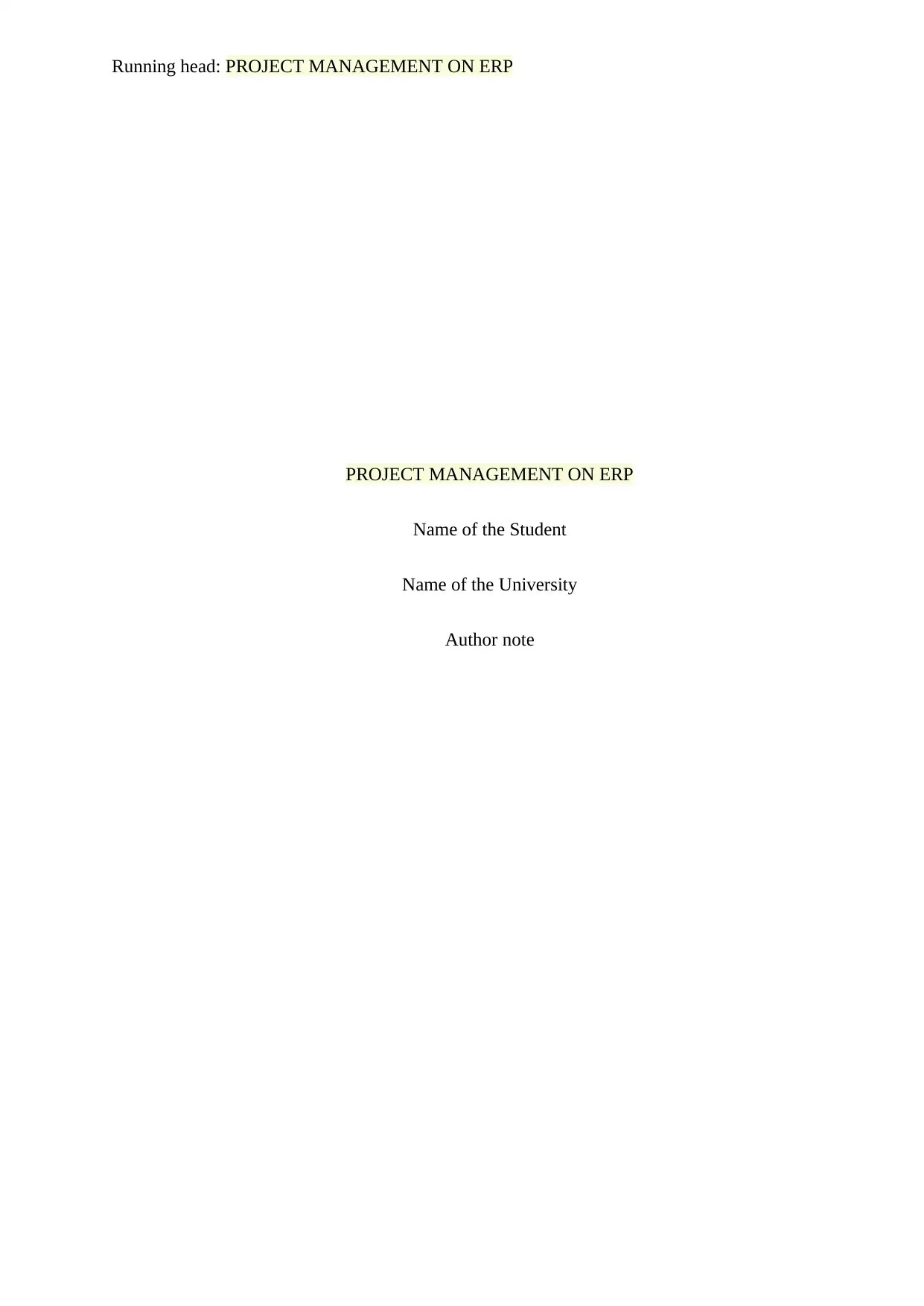
Running head: PROJECT MANAGEMENT ON ERP
PROJECT MANAGEMENT ON ERP
Name of the Student
Name of the University
Author note
PROJECT MANAGEMENT ON ERP
Name of the Student
Name of the University
Author note
Paraphrase This Document
Need a fresh take? Get an instant paraphrase of this document with our AI Paraphraser

1PROJECT MANAGEMENT ON ERP
Table of Contents
Introduction....................................................................................................................2
Issues that occur in a project that result in poor execution of the plan..........................2
Specific consequences to the project’s poor execution:.................................................3
Actions to ensure the success of ERP:...........................................................................5
Summary and Conclusion..............................................................................................6
References......................................................................................................................7
Table of Contents
Introduction....................................................................................................................2
Issues that occur in a project that result in poor execution of the plan..........................2
Specific consequences to the project’s poor execution:.................................................3
Actions to ensure the success of ERP:...........................................................................5
Summary and Conclusion..............................................................................................6
References......................................................................................................................7

2PROJECT MANAGEMENT ON ERP
Introduction
Enterprise resource planning is a software that manages business processeswhich
enables an enterprise to use integrated application system for management of the function of
the organisation and services in the back office that are related to technology (Abu-Hussein,
2016). To overcome the legacy problem much small big organisation implement the ERP.
The implementation of Enterprise Resource Planning in a minute or medium size
organisation is risky. Several issues that arise in a project result in unsuccessful execution of
a plan. The improper implementation of the project can result in severe consequences and can
be a significant threat to the organisation. The problems that arise when ERP is implemented
in the ECS division. Some necessary steps need to be taken for the process of project
management to ensure that the EME division will be successful. However, ERP has increased
the sales, but the implementation of the same brings several challenges such as setup errors,
setting up two divisions separately for one organisation (Bahssas, AlBar&Hoque, 2015).
Issues that occur in a project that result in poor execution of the plan
1. The plan of ERP system was approved in the year 2007, November and the date of
implementation as given by CFO was 2008, July. The six months’ time that is given
to the employees for installing the software, data conversions system testing, and
providing the employees training for using ECS data. The work on trial and
conversion of data began after 2008, April(Malinowska&Rzeczycki, 2017).
2. The project manager was not assigned from the starting of the project. According to
the CFO, the project manager is IT, manager. This creates a problem in the execution
of the plan as the IT manager deprived of any authority regarding the project. The
decisions are needed to be approve by the CFO. The IT manager is not allowed to use
tools like PERT that could help in showing the facts that there is an insufficient date,
Introduction
Enterprise resource planning is a software that manages business processeswhich
enables an enterprise to use integrated application system for management of the function of
the organisation and services in the back office that are related to technology (Abu-Hussein,
2016). To overcome the legacy problem much small big organisation implement the ERP.
The implementation of Enterprise Resource Planning in a minute or medium size
organisation is risky. Several issues that arise in a project result in unsuccessful execution of
a plan. The improper implementation of the project can result in severe consequences and can
be a significant threat to the organisation. The problems that arise when ERP is implemented
in the ECS division. Some necessary steps need to be taken for the process of project
management to ensure that the EME division will be successful. However, ERP has increased
the sales, but the implementation of the same brings several challenges such as setup errors,
setting up two divisions separately for one organisation (Bahssas, AlBar&Hoque, 2015).
Issues that occur in a project that result in poor execution of the plan
1. The plan of ERP system was approved in the year 2007, November and the date of
implementation as given by CFO was 2008, July. The six months’ time that is given
to the employees for installing the software, data conversions system testing, and
providing the employees training for using ECS data. The work on trial and
conversion of data began after 2008, April(Malinowska&Rzeczycki, 2017).
2. The project manager was not assigned from the starting of the project. According to
the CFO, the project manager is IT, manager. This creates a problem in the execution
of the plan as the IT manager deprived of any authority regarding the project. The
decisions are needed to be approve by the CFO. The IT manager is not allowed to use
tools like PERT that could help in showing the facts that there is an insufficient date,
⊘ This is a preview!⊘
Do you want full access?
Subscribe today to unlock all pages.

Trusted by 1+ million students worldwide
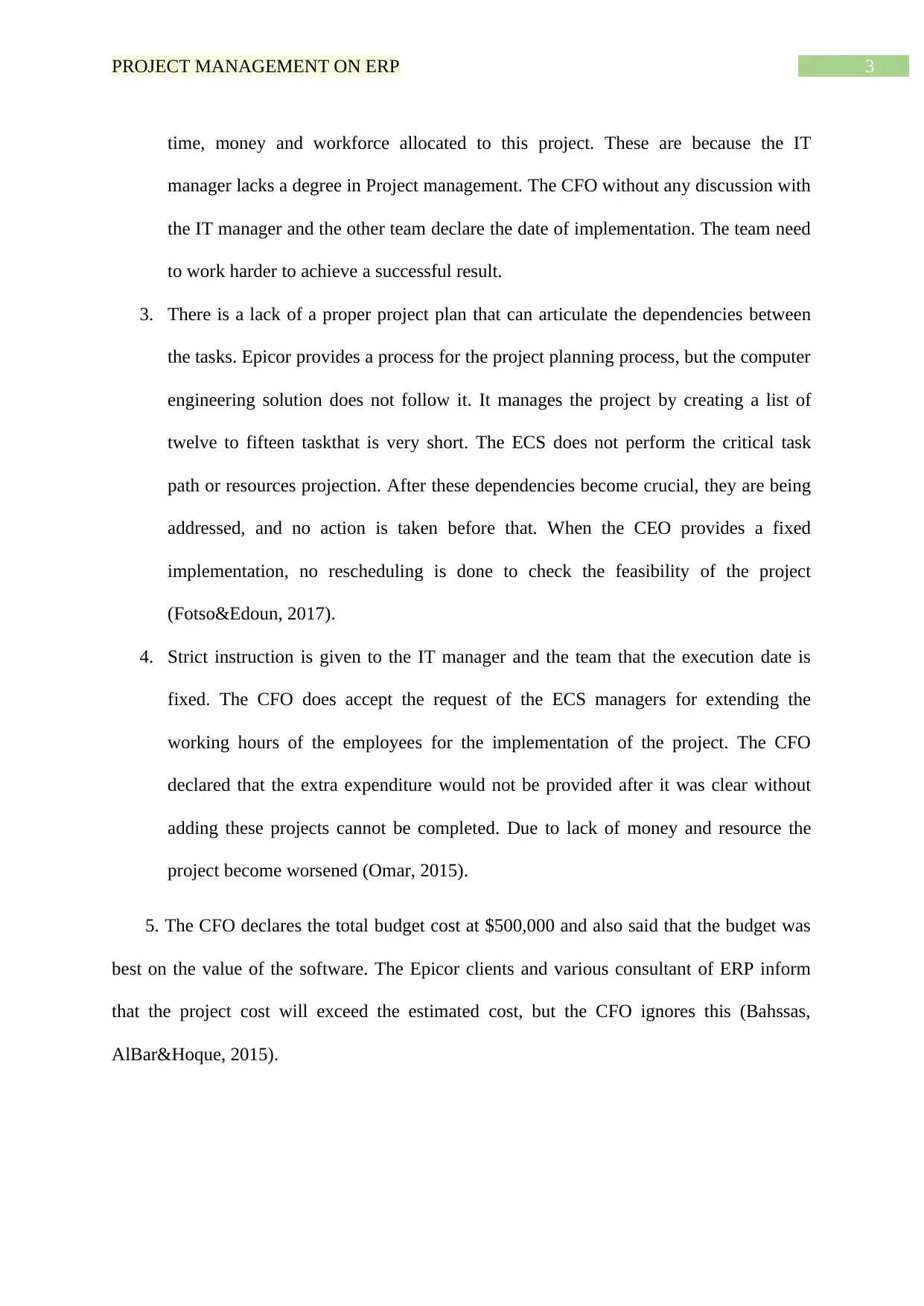
3PROJECT MANAGEMENT ON ERP
time, money and workforce allocated to this project. These are because the IT
manager lacks a degree in Project management. The CFO without any discussion with
the IT manager and the other team declare the date of implementation. The team need
to work harder to achieve a successful result.
3. There is a lack of a proper project plan that can articulate the dependencies between
the tasks. Epicor provides a process for the project planning process, but the computer
engineering solution does not follow it. It manages the project by creating a list of
twelve to fifteen taskthat is very short. The ECS does not perform the critical task
path or resources projection. After these dependencies become crucial, they are being
addressed, and no action is taken before that. When the CEO provides a fixed
implementation, no rescheduling is done to check the feasibility of the project
(Fotso&Edoun, 2017).
4. Strict instruction is given to the IT manager and the team that the execution date is
fixed. The CFO does accept the request of the ECS managers for extending the
working hours of the employees for the implementation of the project. The CFO
declared that the extra expenditure would not be provided after it was clear without
adding these projects cannot be completed. Due to lack of money and resource the
project become worsened (Omar, 2015).
5. The CFO declares the total budget cost at $500,000 and also said that the budget was
best on the value of the software. The Epicor clients and various consultant of ERP inform
that the project cost will exceed the estimated cost, but the CFO ignores this (Bahssas,
AlBar&Hoque, 2015).
time, money and workforce allocated to this project. These are because the IT
manager lacks a degree in Project management. The CFO without any discussion with
the IT manager and the other team declare the date of implementation. The team need
to work harder to achieve a successful result.
3. There is a lack of a proper project plan that can articulate the dependencies between
the tasks. Epicor provides a process for the project planning process, but the computer
engineering solution does not follow it. It manages the project by creating a list of
twelve to fifteen taskthat is very short. The ECS does not perform the critical task
path or resources projection. After these dependencies become crucial, they are being
addressed, and no action is taken before that. When the CEO provides a fixed
implementation, no rescheduling is done to check the feasibility of the project
(Fotso&Edoun, 2017).
4. Strict instruction is given to the IT manager and the team that the execution date is
fixed. The CFO does accept the request of the ECS managers for extending the
working hours of the employees for the implementation of the project. The CFO
declared that the extra expenditure would not be provided after it was clear without
adding these projects cannot be completed. Due to lack of money and resource the
project become worsened (Omar, 2015).
5. The CFO declares the total budget cost at $500,000 and also said that the budget was
best on the value of the software. The Epicor clients and various consultant of ERP inform
that the project cost will exceed the estimated cost, but the CFO ignores this (Bahssas,
AlBar&Hoque, 2015).
Paraphrase This Document
Need a fresh take? Get an instant paraphrase of this document with our AI Paraphraser
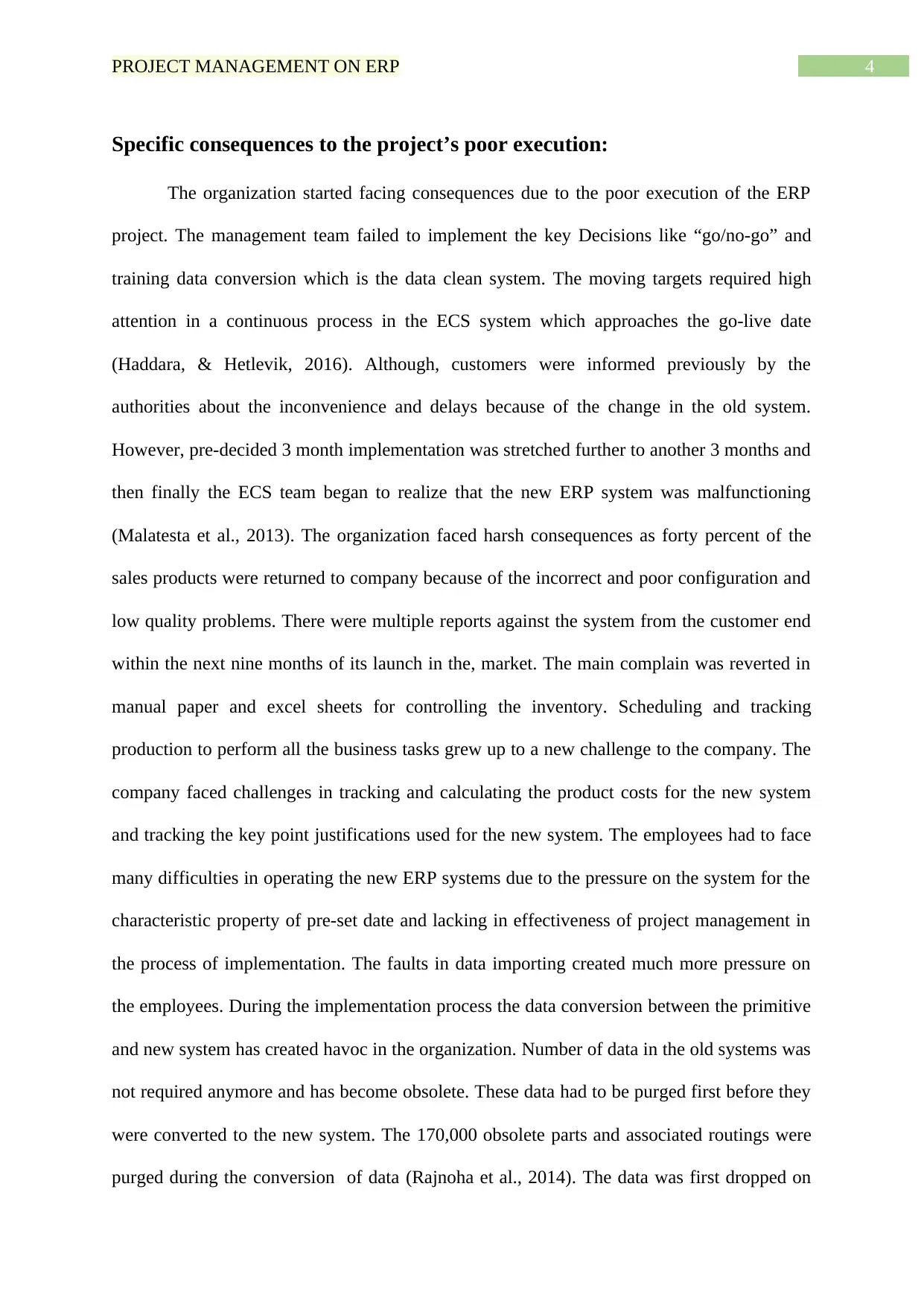
4PROJECT MANAGEMENT ON ERP
Specific consequences to the project’s poor execution:
The organization started facing consequences due to the poor execution of the ERP
project. The management team failed to implement the key Decisions like “go/no-go” and
training data conversion which is the data clean system. The moving targets required high
attention in a continuous process in the ECS system which approaches the go-live date
(Haddara, & Hetlevik, 2016). Although, customers were informed previously by the
authorities about the inconvenience and delays because of the change in the old system.
However, pre-decided 3 month implementation was stretched further to another 3 months and
then finally the ECS team began to realize that the new ERP system was malfunctioning
(Malatesta et al., 2013). The organization faced harsh consequences as forty percent of the
sales products were returned to company because of the incorrect and poor configuration and
low quality problems. There were multiple reports against the system from the customer end
within the next nine months of its launch in the, market. The main complain was reverted in
manual paper and excel sheets for controlling the inventory. Scheduling and tracking
production to perform all the business tasks grew up to a new challenge to the company. The
company faced challenges in tracking and calculating the product costs for the new system
and tracking the key point justifications used for the new system. The employees had to face
many difficulties in operating the new ERP systems due to the pressure on the system for the
characteristic property of pre-set date and lacking in effectiveness of project management in
the process of implementation. The faults in data importing created much more pressure on
the employees. During the implementation process the data conversion between the primitive
and new system has created havoc in the organization. Number of data in the old systems was
not required anymore and has become obsolete. These data had to be purged first before they
were converted to the new system. The 170,000 obsolete parts and associated routings were
purged during the conversion of data (Rajnoha et al., 2014). The data was first dropped on
Specific consequences to the project’s poor execution:
The organization started facing consequences due to the poor execution of the ERP
project. The management team failed to implement the key Decisions like “go/no-go” and
training data conversion which is the data clean system. The moving targets required high
attention in a continuous process in the ECS system which approaches the go-live date
(Haddara, & Hetlevik, 2016). Although, customers were informed previously by the
authorities about the inconvenience and delays because of the change in the old system.
However, pre-decided 3 month implementation was stretched further to another 3 months and
then finally the ECS team began to realize that the new ERP system was malfunctioning
(Malatesta et al., 2013). The organization faced harsh consequences as forty percent of the
sales products were returned to company because of the incorrect and poor configuration and
low quality problems. There were multiple reports against the system from the customer end
within the next nine months of its launch in the, market. The main complain was reverted in
manual paper and excel sheets for controlling the inventory. Scheduling and tracking
production to perform all the business tasks grew up to a new challenge to the company. The
company faced challenges in tracking and calculating the product costs for the new system
and tracking the key point justifications used for the new system. The employees had to face
many difficulties in operating the new ERP systems due to the pressure on the system for the
characteristic property of pre-set date and lacking in effectiveness of project management in
the process of implementation. The faults in data importing created much more pressure on
the employees. During the implementation process the data conversion between the primitive
and new system has created havoc in the organization. Number of data in the old systems was
not required anymore and has become obsolete. These data had to be purged first before they
were converted to the new system. The 170,000 obsolete parts and associated routings were
purged during the conversion of data (Rajnoha et al., 2014). The data was first dropped on
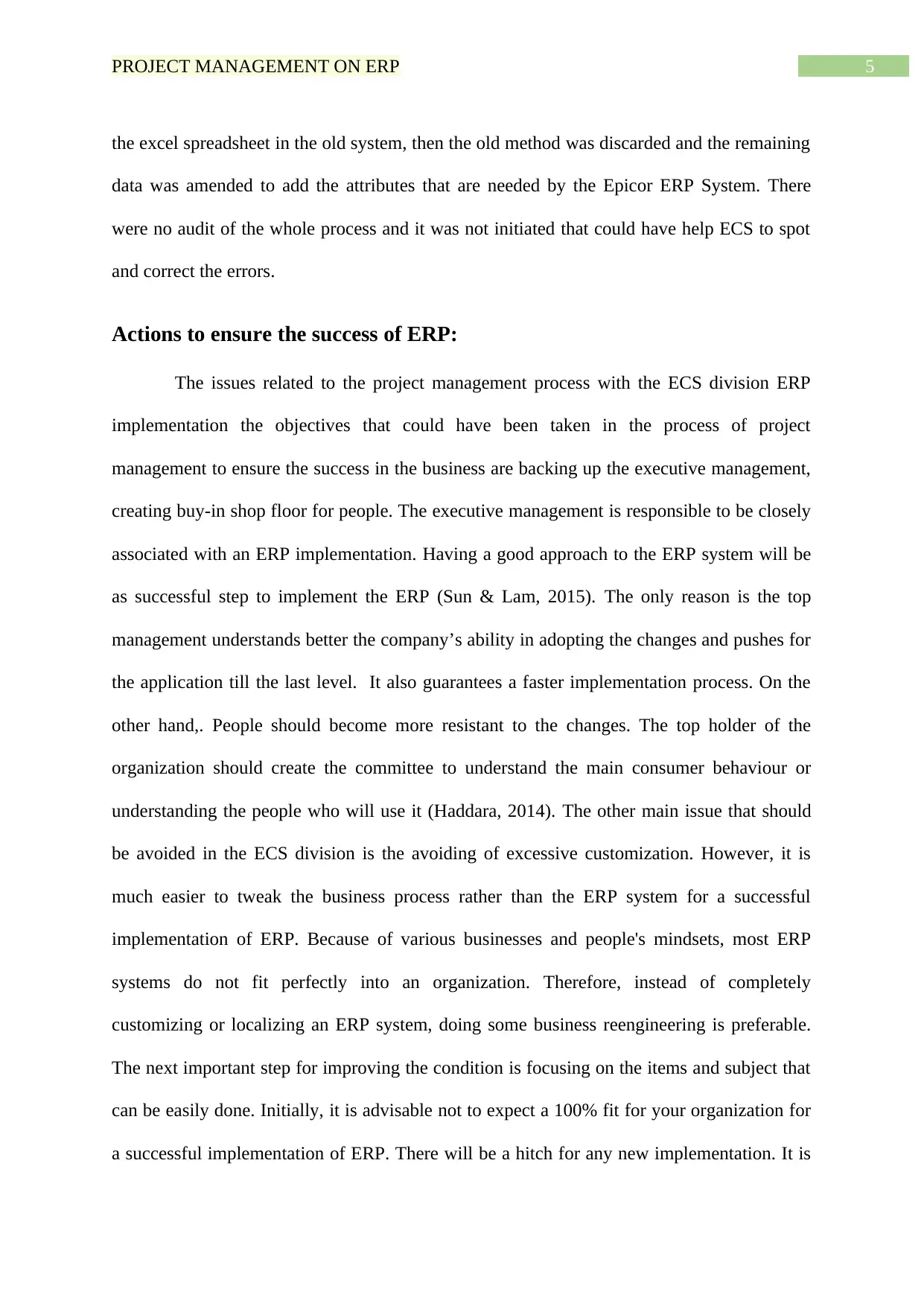
5PROJECT MANAGEMENT ON ERP
the excel spreadsheet in the old system, then the old method was discarded and the remaining
data was amended to add the attributes that are needed by the Epicor ERP System. There
were no audit of the whole process and it was not initiated that could have help ECS to spot
and correct the errors.
Actions to ensure the success of ERP:
The issues related to the project management process with the ECS division ERP
implementation the objectives that could have been taken in the process of project
management to ensure the success in the business are backing up the executive management,
creating buy-in shop floor for people. The executive management is responsible to be closely
associated with an ERP implementation. Having a good approach to the ERP system will be
as successful step to implement the ERP (Sun & Lam, 2015). The only reason is the top
management understands better the company’s ability in adopting the changes and pushes for
the application till the last level. It also guarantees a faster implementation process. On the
other hand,. People should become more resistant to the changes. The top holder of the
organization should create the committee to understand the main consumer behaviour or
understanding the people who will use it (Haddara, 2014). The other main issue that should
be avoided in the ECS division is the avoiding of excessive customization. However, it is
much easier to tweak the business process rather than the ERP system for a successful
implementation of ERP. Because of various businesses and people's mindsets, most ERP
systems do not fit perfectly into an organization. Therefore, instead of completely
customizing or localizing an ERP system, doing some business reengineering is preferable.
The next important step for improving the condition is focusing on the items and subject that
can be easily done. Initially, it is advisable not to expect a 100% fit for your organization for
a successful implementation of ERP. There will be a hitch for any new implementation. It is
the excel spreadsheet in the old system, then the old method was discarded and the remaining
data was amended to add the attributes that are needed by the Epicor ERP System. There
were no audit of the whole process and it was not initiated that could have help ECS to spot
and correct the errors.
Actions to ensure the success of ERP:
The issues related to the project management process with the ECS division ERP
implementation the objectives that could have been taken in the process of project
management to ensure the success in the business are backing up the executive management,
creating buy-in shop floor for people. The executive management is responsible to be closely
associated with an ERP implementation. Having a good approach to the ERP system will be
as successful step to implement the ERP (Sun & Lam, 2015). The only reason is the top
management understands better the company’s ability in adopting the changes and pushes for
the application till the last level. It also guarantees a faster implementation process. On the
other hand,. People should become more resistant to the changes. The top holder of the
organization should create the committee to understand the main consumer behaviour or
understanding the people who will use it (Haddara, 2014). The other main issue that should
be avoided in the ECS division is the avoiding of excessive customization. However, it is
much easier to tweak the business process rather than the ERP system for a successful
implementation of ERP. Because of various businesses and people's mindsets, most ERP
systems do not fit perfectly into an organization. Therefore, instead of completely
customizing or localizing an ERP system, doing some business reengineering is preferable.
The next important step for improving the condition is focusing on the items and subject that
can be easily done. Initially, it is advisable not to expect a 100% fit for your organization for
a successful implementation of ERP. There will be a hitch for any new implementation. It is
⊘ This is a preview!⊘
Do you want full access?
Subscribe today to unlock all pages.

Trusted by 1+ million students worldwide
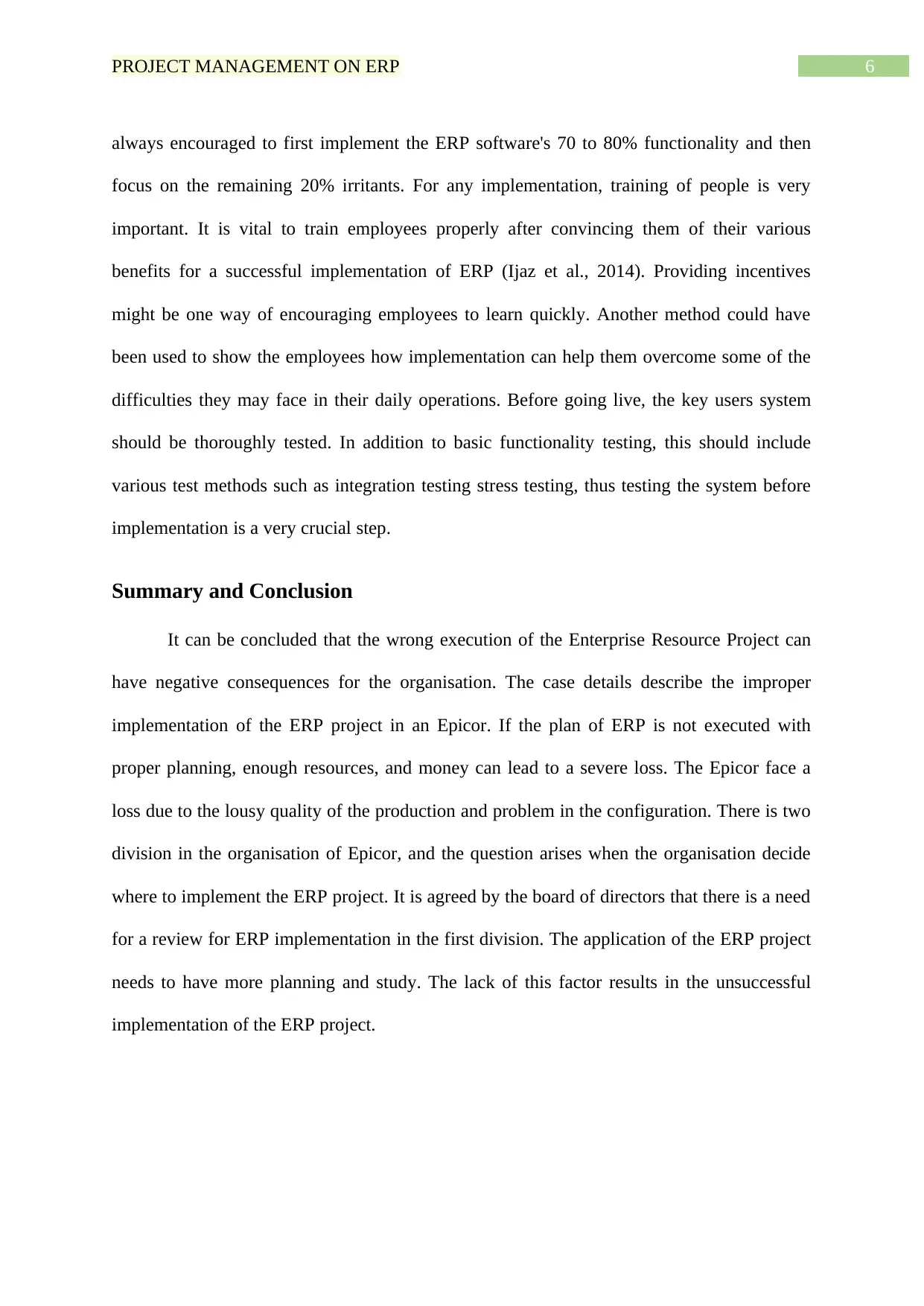
6PROJECT MANAGEMENT ON ERP
always encouraged to first implement the ERP software's 70 to 80% functionality and then
focus on the remaining 20% irritants. For any implementation, training of people is very
important. It is vital to train employees properly after convincing them of their various
benefits for a successful implementation of ERP (Ijaz et al., 2014). Providing incentives
might be one way of encouraging employees to learn quickly. Another method could have
been used to show the employees how implementation can help them overcome some of the
difficulties they may face in their daily operations. Before going live, the key users system
should be thoroughly tested. In addition to basic functionality testing, this should include
various test methods such as integration testing stress testing, thus testing the system before
implementation is a very crucial step.
Summary and Conclusion
It can be concluded that the wrong execution of the Enterprise Resource Project can
have negative consequences for the organisation. The case details describe the improper
implementation of the ERP project in an Epicor. If the plan of ERP is not executed with
proper planning, enough resources, and money can lead to a severe loss. The Epicor face a
loss due to the lousy quality of the production and problem in the configuration. There is two
division in the organisation of Epicor, and the question arises when the organisation decide
where to implement the ERP project. It is agreed by the board of directors that there is a need
for a review for ERP implementation in the first division. The application of the ERP project
needs to have more planning and study. The lack of this factor results in the unsuccessful
implementation of the ERP project.
always encouraged to first implement the ERP software's 70 to 80% functionality and then
focus on the remaining 20% irritants. For any implementation, training of people is very
important. It is vital to train employees properly after convincing them of their various
benefits for a successful implementation of ERP (Ijaz et al., 2014). Providing incentives
might be one way of encouraging employees to learn quickly. Another method could have
been used to show the employees how implementation can help them overcome some of the
difficulties they may face in their daily operations. Before going live, the key users system
should be thoroughly tested. In addition to basic functionality testing, this should include
various test methods such as integration testing stress testing, thus testing the system before
implementation is a very crucial step.
Summary and Conclusion
It can be concluded that the wrong execution of the Enterprise Resource Project can
have negative consequences for the organisation. The case details describe the improper
implementation of the ERP project in an Epicor. If the plan of ERP is not executed with
proper planning, enough resources, and money can lead to a severe loss. The Epicor face a
loss due to the lousy quality of the production and problem in the configuration. There is two
division in the organisation of Epicor, and the question arises when the organisation decide
where to implement the ERP project. It is agreed by the board of directors that there is a need
for a review for ERP implementation in the first division. The application of the ERP project
needs to have more planning and study. The lack of this factor results in the unsuccessful
implementation of the ERP project.
Paraphrase This Document
Need a fresh take? Get an instant paraphrase of this document with our AI Paraphraser

7PROJECT MANAGEMENT ON ERP
References:
Abu-Hussein, R., Hyassat, M., Sweis, R., Alawneh, A., & Al-Debei, M. (2016).
Project management factors are affecting the enterprise resource planning projects'
performance in Jordan. Journal of Systems and Information Technology, 18(3), 230-254.
Bahssas, D. M., AlBar, A. M., &Hoque, M. R. (2015). Enterprise resource planning
(ERP) systems: design, trends and deployment. The International Technology Management
Review, 5(2), 72-81.
Bahssas, D. M., AlBar, A. M., &Hoque, M. R. (2015). Enterprise resource planning
(ERP) systems: design, trends and deployment. The International Technology Management
Review, 5(2), 72-81.
Fotso, G. B., &Edoun, E. I. (2017, September). The effectiveness of Information
System Trough Enterprise Resource Planning (Erp) and Project Management. In ECISM
2017 11th European Conference on Information Systems Management(p. 121). Academic
Conferences and publishing limited.
Haddara, M. (2014). ERP selection: the SMART way. Procedia Technology, 16, 394-
403.
Haddara, M., & Hetlevik, T. (2016). Investigating the Effectiveness of Traditional
Support Structures & Self-organizing Entities within the ERP Shakedown Phase. Procedia
Computer Science, 100, 507-516.
Ijaz, A., Malik, R. K., Lodhi, R. N., Habiba, U., & Irfan, S. M. (2014, January). A
qualitative study of the critical success factors of ERP system-A case study approach.
References:
Abu-Hussein, R., Hyassat, M., Sweis, R., Alawneh, A., & Al-Debei, M. (2016).
Project management factors are affecting the enterprise resource planning projects'
performance in Jordan. Journal of Systems and Information Technology, 18(3), 230-254.
Bahssas, D. M., AlBar, A. M., &Hoque, M. R. (2015). Enterprise resource planning
(ERP) systems: design, trends and deployment. The International Technology Management
Review, 5(2), 72-81.
Bahssas, D. M., AlBar, A. M., &Hoque, M. R. (2015). Enterprise resource planning
(ERP) systems: design, trends and deployment. The International Technology Management
Review, 5(2), 72-81.
Fotso, G. B., &Edoun, E. I. (2017, September). The effectiveness of Information
System Trough Enterprise Resource Planning (Erp) and Project Management. In ECISM
2017 11th European Conference on Information Systems Management(p. 121). Academic
Conferences and publishing limited.
Haddara, M. (2014). ERP selection: the SMART way. Procedia Technology, 16, 394-
403.
Haddara, M., & Hetlevik, T. (2016). Investigating the Effectiveness of Traditional
Support Structures & Self-organizing Entities within the ERP Shakedown Phase. Procedia
Computer Science, 100, 507-516.
Ijaz, A., Malik, R. K., Lodhi, R. N., Habiba, U., & Irfan, S. M. (2014, January). A
qualitative study of the critical success factors of ERP system-A case study approach.

8PROJECT MANAGEMENT ON ERP
In Proceedings of the International Conference on Industrial Engineering and Operations
Management, Bali, Indonesia (Vol. 7, No. 9, pp. 2556-2566).
Malatesta, M., Raffaeli, R., Mengoni, M., & Germani, M. (2013). Supporting the
modification process of products through a change management tool.
Malinowska, M., &Rzeczycki, A. (2017). Implementation of The Enterprise Resource
Planning Systems: Case Studies of Failures and Their Impact on The Enterprise
Operation. Value of Failure: The Spectrum of Challenges for the Economy, 75.
Omar, K. (2015). Towards improving the usability of mobile ERP. A model for
devising adaptive mobile is to enhance the usability of mobile ERP. INFORMATIK 2015.
Rajnoha, R., Kádárová, J., Sujová, A., & Kádár, G. (2014). Business information
systems: research study and methodological proposals for ERP implementation process
improvement. Procedia-social and behavioral sciences, 109, 165-170.
Sun, H., Ni, W., & Lam, R. (2015). A step-by-step performance assessment and
improvement method for ERP implementation: Action case studies in Chinese
companies. Computers in Industry, 68, 40-52.
In Proceedings of the International Conference on Industrial Engineering and Operations
Management, Bali, Indonesia (Vol. 7, No. 9, pp. 2556-2566).
Malatesta, M., Raffaeli, R., Mengoni, M., & Germani, M. (2013). Supporting the
modification process of products through a change management tool.
Malinowska, M., &Rzeczycki, A. (2017). Implementation of The Enterprise Resource
Planning Systems: Case Studies of Failures and Their Impact on The Enterprise
Operation. Value of Failure: The Spectrum of Challenges for the Economy, 75.
Omar, K. (2015). Towards improving the usability of mobile ERP. A model for
devising adaptive mobile is to enhance the usability of mobile ERP. INFORMATIK 2015.
Rajnoha, R., Kádárová, J., Sujová, A., & Kádár, G. (2014). Business information
systems: research study and methodological proposals for ERP implementation process
improvement. Procedia-social and behavioral sciences, 109, 165-170.
Sun, H., Ni, W., & Lam, R. (2015). A step-by-step performance assessment and
improvement method for ERP implementation: Action case studies in Chinese
companies. Computers in Industry, 68, 40-52.
⊘ This is a preview!⊘
Do you want full access?
Subscribe today to unlock all pages.

Trusted by 1+ million students worldwide

9PROJECT MANAGEMENT ON ERP
1 out of 10
Related Documents
Your All-in-One AI-Powered Toolkit for Academic Success.
+13062052269
info@desklib.com
Available 24*7 on WhatsApp / Email
![[object Object]](/_next/static/media/star-bottom.7253800d.svg)
Unlock your academic potential
Copyright © 2020–2025 A2Z Services. All Rights Reserved. Developed and managed by ZUCOL.





